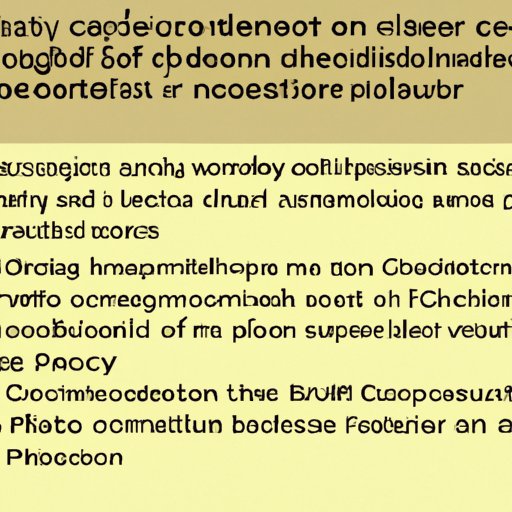Introduction
The term “trip” is often used to describe a psychedelic experience that alters an individual’s perception and consciousness. While some may associate this term with psychedelics such as LSD, psilocybin mushrooms, or ayahuasca, there is a growing interest in the potential psychedelic effects of other natural substances, like cacao. But what exactly is cacao, and can it really make you trip? Let’s take a closer look.
Exploring the Psychedelic Effects of Cacao
Cacao is a tropical evergreen tree native to South America and Central America, which produces pods filled with seeds called cocoa beans. The dried and fermented cocoa beans are then processed into cocoa powder, cocoa butter, and chocolate, which are widely consumed around the world. But does cacao have any psychedelic effects?
What is a Psychedelic Effect?
A psychedelic effect is a type of altered state of consciousness characterized by changes in perception, mood, and cognitive processes. These effects can range from mild to intense and can be triggered by various substances, such as psychedelics, marijuana, and even certain foods.
Does Cacao Have Any Psychedelic Effects?
Cacao has been used for centuries by indigenous cultures in Central and South America for its medicinal properties, including its potential to induce psychedelic effects. It contains several compounds, such as theobromine, phenylethylamine, anandamide, and tryptophan, which may contribute to its psychoactive properties. But does cacao contain hallucinogenic compounds?
The Chemistry of Cacao
Cacao contains several compounds that may have psychotropic effects, including theobromine, phenylethylamine, anandamide, and tryptophan. Theobromine, a stimulant found in cacao, can produce feelings of alertness and euphoria. Phenylethylamine, another compound found in cacao, is thought to increase levels of dopamine in the brain, resulting in decreased stress and improved mood. Anandamide, an endocannabinoid found in cacao, is believed to interact with the endocannabinoid system and produce feelings of relaxation and euphoria. Finally, tryptophan, an amino acid found in cacao, can increase serotonin levels, resulting in improved sleep and mood.
Does Cacao Contain Hallucinogenic Compounds?
While cacao does contain several compounds that may have psychotropic effects, it does not contain any known hallucinogenic compounds. However, some studies suggest that cacao may still be capable of inducing psychedelic-like experiences, due to its ability to alter brain chemistry.
Is Cacao a Hallucinogenic Drug?
No, cacao is not considered a hallucinogenic drug. A hallucinogenic drug is defined as a substance that induces hallucinations, altered states of consciousness, and other perceptual distortions. While cacao may produce some of these effects, it is not considered a hallucinogenic drug.
Can Cacao Really Make You Trip?
While there is no scientific evidence to support the claim that cacao can make you trip, some people believe that it can produce psychedelic-like experiences. Different types of trips induced by cacao may include increased feelings of euphoria, heightened sensory awareness, and altered perceptions of time and space. However, it is important to note that these effects may vary from person to person and should not be taken lightly.

Possible Risks Associated with Taking Cacao
It is important to note that while cacao may have some potential therapeutic benefits, it is also associated with some risks. Some of these risks include anxiety, restlessness, insomnia, and headaches. It is also important to keep in mind that cacao is a stimulant, so it should not be taken in large amounts or combined with other stimulants. Additionally, it is best to consult with a healthcare professional before taking any form of cacao.
The Science Behind Cacao’s Ability to Induce Trippy Experiences
So how does cacao affect the brain? Studies suggest that cacao may act on the brain’s reward system, increasing levels of dopamine and other neurotransmitters. This could explain why some people experience increased feelings of euphoria and altered states of consciousness when taking cacao. Additionally, cacao may affect the brain’s serotonin system, resulting in increased feelings of relaxation and improved sleep. However, more research is needed to understand the exact mechanisms behind cacao’s effects on the brain.
How Can We Use Cacao Safely?
When using cacao for its potential psychedelic effects, it is important to follow safety guidelines. First, it is best to start with a small dose and work your way up to a larger dose over time. Additionally, it is important to be mindful of any potential side effects, such as anxiety or headaches, and to stop taking cacao if these occur. Finally, it is important to consult with a healthcare professional before taking any form of cacao.
Conclusion
In conclusion, cacao is a natural substance that may have some potential psychedelic effects. While it does not contain any hallucinogenic compounds, it can alter brain chemistry and induce trippy experiences. However, it is important to proceed with caution when taking cacao and to consult with a healthcare professional before doing so. Ultimately, more research is needed to fully understand the effects of cacao on the brain and its potential therapeutic benefits.
(Note: Is this article not meeting your expectations? Do you have knowledge or insights to share? Unlock new opportunities and expand your reach by joining our authors team. Click Registration to join us and share your expertise with our readers.)
